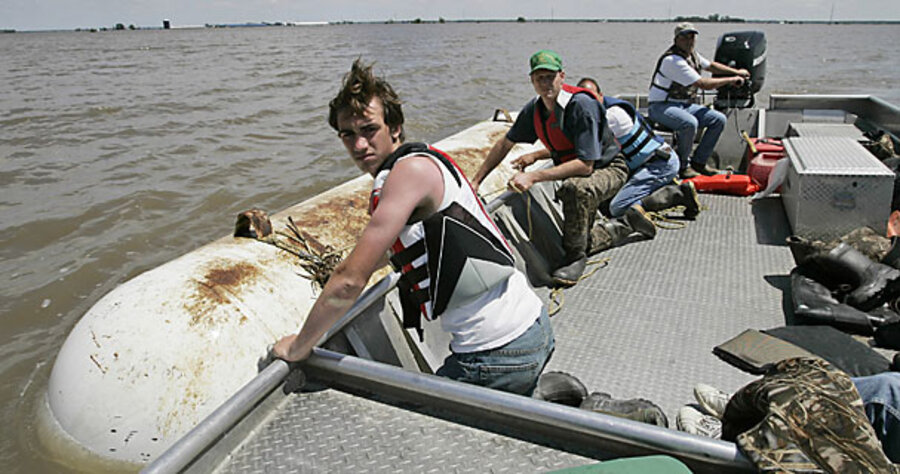Midwest’s postflood risk: toxic basements
Loading...
The oil, gasoline, fertilizers, and herbicides swept away by floodwaters in June pose an environmental challenge to the rain-soaked Midwest.
But some of the most serious pollution problems may not lie outdoors. Instead, they could well lurk indoors in waterlogged basements and first floors of homes and businesses, where everything from cleaning agents to toxic metals accumulate in silt and mold.
These concerns about indoor toxins, which sprang up in the aftermath of the New Orleans flood in 2005, have led researchers to begin working on tools that could give emergency crews and homeowners a better idea of the risks they face when they step through the front door once floodwaters recede.
Indoor muck following a flood is a common problem, says Nicholas Ashley, a researcher at Louisiana State University in Baton Rouge involved in the work. But, he adds, “to the best of our knowledge no one had looked at the effect of interior sediment deposits” on pollution levels until he and his PhD adviser, Louis Thibodeaux, began to tackle the issue after hurricane Katrina flooded New Orleans.
The problem is that flood victims get an OK to return and begin the cleanup based on contaminant levels measured outdoors. But those measurements may significantly underestimate what awaits when people walk inside, he says.
After Katrina, pollution levels in floodwater looked a lot like typical storm water, according to measurements by another Louisiana State University team.
But the interiors of two homes Mr. Ashley and Dr. Thibodeaux sampled told a different story: Levels of arsenic, cadmium, vanadium, and lead in the homes were substantially higher than the maximum levels that the Environmental Protection Agency (EPA) considers safe. “Three of those metals exceeded the outdoor concentrations in some cases by even greater margins,” Ashley says.
The metals, it turns out, cling to the fine silt particles that enter a home as floodwaters seep in through chinks and cracks. The silt then settles out in layers only a few millimeters deep.
Meanwhile, waterborne organic chemicals prone to evaporation also seep inside or get augmented by what’s already in the house. Mold can absorb and retain the organics in the gas, then redistribute them when it releases its spores. A field study led by Ginger Chew, with the department of environmental health sciences at Columbia University in New York, found that spore concentrations in several once-flooded New Orleans homes reached levels that outstripped the ability of a popular respirator to deal with them.
Building interiors – from warehouses to residential garages and basements – face other, better-known threats.
Many already store gasoline, cleaning agents, or home heating oil. When floodwater fills a basement, it can float a 250-gallon heating oil tank. Once the tank breaks free of its fittings, the oil leaks and can eventually spread outdoors, notes Bill Simes, who heads a US EPA response team that has been working with Indiana to scope out the extent of pollution triggered by the floods. Submerged TVs and other electronic devices leach metals.
Depending on the location, add “biologicals” to the list, Mr. Simes says, recalling work he and his team did in New Orleans after Katrina. “The fishing industry stores large amounts of shrimp. When the refrigeration goes off for about 30 days, it’s not really shrimp anymore.”
Floodwaters also bring with them a background level of pollutants. And they pick up more along the way.
In states such as Iowa, where farming is widespread, floodwaters pick up organic material such as fertilizers and herbicides from cropland.
Now, Ashley and Thibodeaux are working on a model that could give first responders and homeowners a clearer idea of the pollution levels they are likely to face once the water recedes – particularly in farm country, where organics can form the dominant class of pollutants. A key part of the puzzle still to be incorporated involves how airtight the home is and how long it remains buttoned up before restoration or demolition begins. The duo acknowledges they are operating on sparse data – two houses. It’s crucial, they say, to develop simple water and sediment sampling kits that rescuers and other first responders can use. Such data would allow them to expand their sample of structures and provide information needed to run the model.





